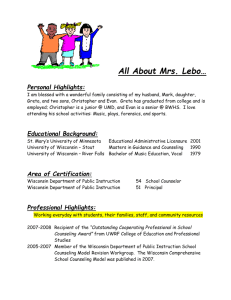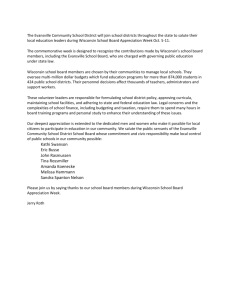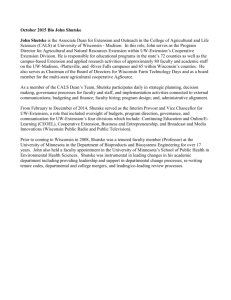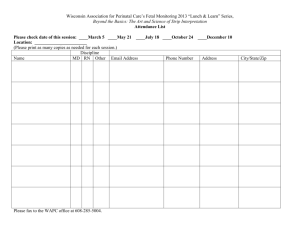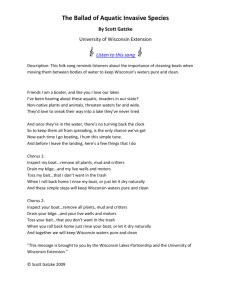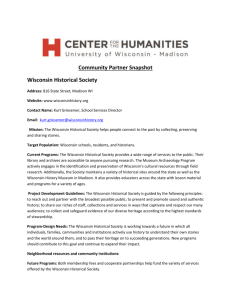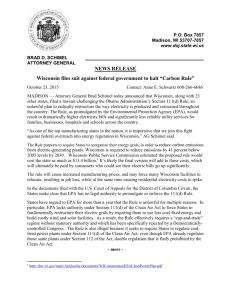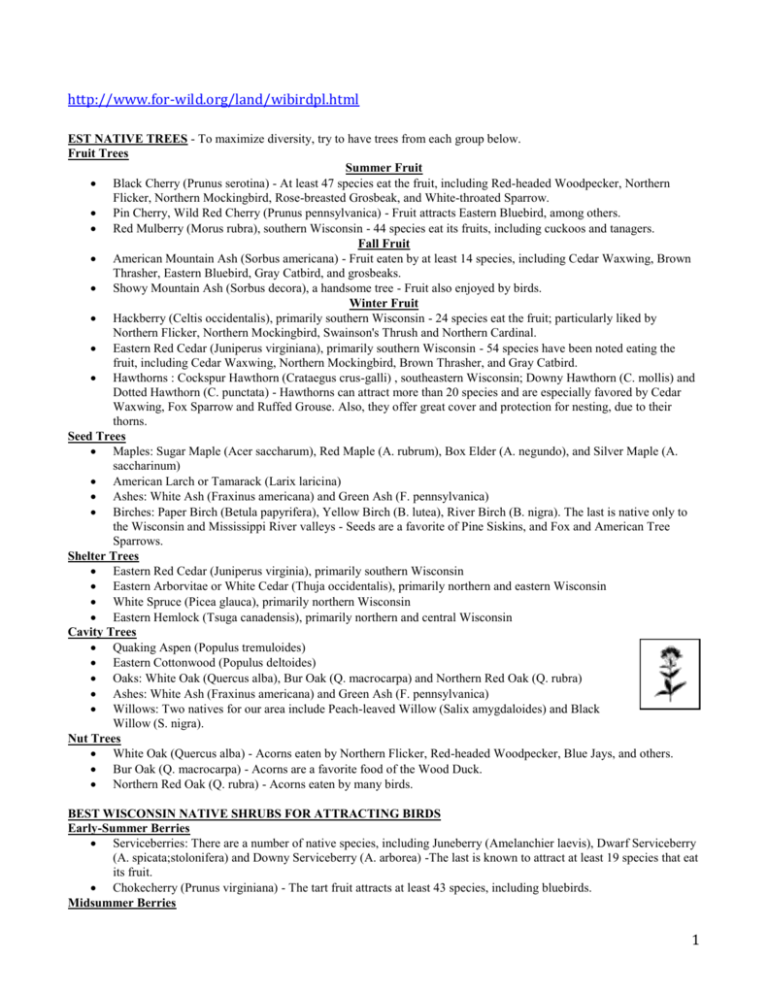
http://www.for-wild.org/land/wibirdpl.html
EST NATIVE TREES - To maximize diversity, try to have trees from each group below.
Fruit Trees
Summer Fruit
Black Cherry (Prunus serotina) - At least 47 species eat the fruit, including Red-headed Woodpecker, Northern
Flicker, Northern Mockingbird, Rose-breasted Grosbeak, and White-throated Sparrow.
Pin Cherry, Wild Red Cherry (Prunus pennsylvanica) - Fruit attracts Eastern Bluebird, among others.
Red Mulberry (Morus rubra), southern Wisconsin - 44 species eat its fruits, including cuckoos and tanagers.
Fall Fruit
American Mountain Ash (Sorbus americana) - Fruit eaten by at least 14 species, including Cedar Waxwing, Brown
Thrasher, Eastern Bluebird, Gray Catbird, and grosbeaks.
Showy Mountain Ash (Sorbus decora), a handsome tree - Fruit also enjoyed by birds.
Winter Fruit
Hackberry (Celtis occidentalis), primarily southern Wisconsin - 24 species eat the fruit; particularly liked by
Northern Flicker, Northern Mockingbird, Swainson's Thrush and Northern Cardinal.
Eastern Red Cedar (Juniperus virginiana), primarily southern Wisconsin - 54 species have been noted eating the
fruit, including Cedar Waxwing, Northern Mockingbird, Brown Thrasher, and Gray Catbird.
Hawthorns : Cockspur Hawthorn (Crataegus crus-galli) , southeastern Wisconsin; Downy Hawthorn (C. mollis) and
Dotted Hawthorn (C. punctata) - Hawthorns can attract more than 20 species and are especially favored by Cedar
Waxwing, Fox Sparrow and Ruffed Grouse. Also, they offer great cover and protection for nesting, due to their
thorns.
Seed Trees
Maples: Sugar Maple (Acer saccharum), Red Maple (A. rubrum), Box Elder (A. negundo), and Silver Maple (A.
saccharinum)
American Larch or Tamarack (Larix laricina)
Ashes: White Ash (Fraxinus americana) and Green Ash (F. pennsylvanica)
Birches: Paper Birch (Betula papyrifera), Yellow Birch (B. lutea), River Birch (B. nigra). The last is native only to
the Wisconsin and Mississippi River valleys - Seeds are a favorite of Pine Siskins, and Fox and American Tree
Sparrows.
Shelter Trees
Eastern Red Cedar (Juniperus virginia), primarily southern Wisconsin
Eastern Arborvitae or White Cedar (Thuja occidentalis), primarily northern and eastern Wisconsin
White Spruce (Picea glauca), primarily northern Wisconsin
Eastern Hemlock (Tsuga canadensis), primarily northern and central Wisconsin
Cavity Trees
Quaking Aspen (Populus tremuloides)
Eastern Cottonwood (Populus deltoides)
Oaks: White Oak (Quercus alba), Bur Oak (Q. macrocarpa) and Northern Red Oak (Q. rubra)
Ashes: White Ash (Fraxinus americana) and Green Ash (F. pennsylvanica)
Willows: Two natives for our area include Peach-leaved Willow (Salix amygdaloides) and Black
Willow (S. nigra).
Nut Trees
White Oak (Quercus alba) - Acorns eaten by Northern Flicker, Red-headed Woodpecker, Blue Jays, and others.
Bur Oak (Q. macrocarpa) - Acorns are a favorite food of the Wood Duck.
Northern Red Oak (Q. rubra) - Acorns eaten by many birds.
BEST WISCONSIN NATIVE SHRUBS FOR ATTRACTING BIRDS
Early-Summer Berries
Serviceberries: There are a number of native species, including Juneberry (Amelanchier laevis), Dwarf Serviceberry
(A. spicata;stolonifera) and Downy Serviceberry (A. arborea) -The last is known to attract at least 19 species that eat
its fruit.
Chokecherry (Prunus virginiana) - The tart fruit attracts at least 43 species, including bluebirds.
Midsummer Berries
1
Blackberries/Raspberries (Rubus sp.): Red Raspberry (R. idaeus; strigosus), Blackcap Raspberry (R.
occidentalis),and Highbush Blackberry (R. allegheniensis) - At least 63 species eat their fruit.
American Elderberry (Sambucus canadensis) - At least 33 species eat its fruit, including Red-bellied and Redheaded Woodpeckers, Eastern Bluebird, American Robin and Northern Cardinal.
Currants/Gooseberries (Ribes spp.): Choose native species like Wild Black Currant (R. americanum), Missouri
Gooseberry (R. Missouriense) and Prickly Gooseberry (R. cynosbati) - The berries are eaten by at least 16 species of
birds.
Canadian Buffalo Berry (Shepherdia canadensis), native along Lakes Michigan and Superior.
Blueberries (Vaccinium sp.), Low-bush blueberry (V. angustifolium), Canada Blueberry (V. Myrtilloides).
Fall Berries
Dogwoods (Cornus spp.):
Pagoda Dogwood (C. alternifolia) - Fruits eaten by at least 34 species, including Downy Woodpecker, Brown
Thrasher, Wood Thrush, Eastern Bluebird, and Cedar Waxwing.
Red-Osier Dogwood (C. stolonifera) - Fruits eaten by at least 18 species, including Gray Catbird and Wild Turkey.
Silky Dogwood (C. amomum) - At least 18 species feed on fruits.
Gray Dogwood (C. racemosa) - Its fruit is consumed by at least 17 species, including Northern Flicker, Downy
Woodpecker, Northern Cardinal, and Eastern Bluebird.
Viburnums (Viburnum spp.):
Nannyberry (V. lentago) - Among birds feeding on its fruit are Gray Catbird, American Robin, Eastern Bluebird,
and Cedar Waxwing.
Downy Arrowwood (V. Rafinesquianum)
Winter Berries
Winterberry, (Ilex verticillata ) - Fruits eaten by songbirds, winter waterfowl, and upland game birds.
Sumacs (Rhus spp.):
Smooth Sumac (R. glabra) - At least 3l species eat the fruits, especially the Gray Catbird, Wood Thrush,and Eastern
Bluebird.
Staghorn Sumac (R.. hirta; typhina) - 21 species eat the fruit , including Red-eyed Vireo and American Robin.
Roses (Rosa spp.). Get native species that don't need pesticides and fertilizers:
Swamp Rose (R. palustris) - Its rose hips are eaten by at least 20 species and are preferred by Swainson's Thrush and
Cedar Waxwing.
Pasture Rose (R. carolina)
Meadow Rose (R. blanda)
Prairie Wild Rose (R. arkansana) - At least 38 species feed on its hips, including Northern Cardinal and Brown
Thrasher.
Shrubs for Nests
Speckled Alder (Alnus incana subsp.rugosa); Green Alder (A. viridis), latter is primarily in northern Wisconsin.
American Elderberry (Sambucas canadensis)
Roses (Rosa spp.): Swamp Rose (R. palustris), Pasture Rose (R. carolina), Meadow Rose (R. blanda)
Willows (Salix spp.): Pussy Willow (S. discolor), Prairie Willow (S. humilis), Beaked Willow (S. bebbiana)
Ninebark (Physocarpus opulifolius)
Shrubs for Shelter
Common Juniper (Juniperus communis), Southern half of Wisconsin. - Eastern Bluebird, Cedar Waxwing, and
Purple Finch eat the berries.
Shrubs for Seeds
Speckled Alder (Alnus incana subsp. rugosa); Green Alder (A. viridis), latter is primarily in northern Wisconsin.
BEST WISCONSIN NATIVE VINES FOR ATTRACTING BIRDS
Vines for Berries All provide fall and winter fruit.
American Bittersweet (Celastrus scandens) - At least 15 species of birds eat the berries.
Poison Ivy (Rhus radicans) - At least 55 species of birds eat the fruits.
Greenbriar (Smilax hispida); also, Carrion-flowers ( S. ecirrhata and S. herbacea)
Virginia Creeper (Parthenocissus quinquefolia) and Grape Woodbine (P. vitacea) - Favorite berries of at least 35
species, including thrushes, woodpeckers, vireos, and warblers.
Grapes (Vitis spp.):
2
Riverbank Grape (V. riparia ;vulpina) - 52 species eat these grapes; the preferred food of 24.
Pigeon Grape (V. aestivalis), primarily southern half of Wisconsin.
Vines for Shelter and Nesting
Greenbriar (Smilax hispida)
Grapes (Vitis sp) - See above under berries.
Best Vine for Hummingbirds
Trumpet Honeysuckle (Lonicera sempervirens)
BEST WISCONSIN WILDFLOWERS FOR BIRDS
Asters (Aster spp.). Range varies for different species, but asters are found throughout
Wisconsin - Seeds eaten by cardinals, goldfinches, sparrows, chickadees, nuthatches, towhees,
Indigo Buntings.
Coreopsis (Coreopsis spp.), mainly southern half of Wisconsin.
Purple Coneflowers (Echinacea spp.), mainly southern one-fourth of Wisconsin.
Joe-pye Weeds (Eupatorium spp.), south of Tension Zone, which bisects Wisconsin from
northwest to southeast.
Wild Strawberry (Fragaria spp.) - Fruits attract 53 species of birds, including Northern Flicker,
Wood Thrush, Cedar Waxwing, Eastern Towhee, American Robin, Gray Catbird, Brown
Thrasher and Rose-breasted Grosbeaks.
Sunflowers (Helianthus spp.), range varies for different species, but sunflowers are found throughout Wisconsin Seeds loved by Mourning Doves, blackbirds, chickadees, finches, meadowlarks, sparrows, and White- breasted
Nuthatches.
Blazing Stars (Liatris spp.), range varies for different species, but Blazing Stars are found throughout Wisconsin.
Black-eyed Susans (Rudbeckia hirta, R. laciniata.) -Favorite of finches; also liked by chickadees, cardinals,
sparrows, nuthatches, and towhees.
Prairie Dock, Compass Plant, and other Silphiums (Silphium spp.), southern half of Wisconsin -Loved by finches.
Goldenrods (Solidago spp.). Many wonderful natives throughout Wisconsin, but avoid Canada Goldenrod (S.
canadensis), which is extremely aggressive and will crowd out most other wildflowers -Loved by finches.
Ironweed (Vernonia noveboracensis), primarily south of Tension Zone, which bisects Wisconsin from northwest to
southeast.
BEST WISCONSIN WILDFLOWERS FOR HUMMINGBIRDS
Columbine (Aquilegia canadensis)
Butterfly Weed (Asclepias tuberosa)
Spotted Jewelweed (Impatiens capensis)
Cardinal Flower (Lobelia cardinalis)
Turk's Cap Lily (Lilium superbum) and Wood Lily (L. philadelphicum)
Wild Bergamot (Monarda fistulosa)
Lupine (Lupinus perennis), mainly south of Tension Zone which bisects Wisconsin from NW -SE.
Penstemon (Penstemon grandiflorus, P. digitalis), southern two-thirds of Wisconsin.
Phlox (Phlox divaricata, P. pilosa)
BEST WISCONSIN NATIVE GRASSES FOR BIRDS
Bluestems (Andropogon spp.) - Seeds of the Big and Little Bluestem are eaten by small birds in winter, including
juncos and sparrows.
Other native prairie and woodland grasses also have seeds that are probably eaten by birds, but specific information
is unavailable.
WORST WISCONSIN INVASIVE PLANTS - Be sure to eliminate these from your birdscaped yard.
Purple Loosestrife (Lythrum salicaria)
Tartarian Honeysuckle (Lonicera tatarica)
Garlic Mustard (Alliaria petiolata)
Reed Canary Grass (Phalaris arundinacea)
Crown Vetch (Coronilla varia)
3
Common Buckthorn (Rhamnus cathartica) and Glossy Buckthorn (Rhamnus Frangula)
White Sweet Clover (Melilotus alba) and Yellow Sweet Clover (Melilotus alba)
Canada Thistle (Cirsium arvense)
Wild Parsnip (Pastinaca sativa)
Musk or Nodding Thistle (Carduus nutans)
RECOMMENDED READING
Adams, George, 1980. Birdscaping Your Garden. Rodale Press. N.Y. Excellent in advocating only native
plant species for birdscaping.
Cockrane, T. and Hugh H. Iltis. 2000. Atlas of the Wisconsin Prairie and Savanna Flora, Technical Bulletin
No., 191. Wisconsin Department of Natural Resources. Madison, WI. Maps for each species.
Heintzelman, Donald. S. 200l. The Complete Backyard Birdwatcher's Home Companion. Ragged Mountain
Press. Camden, Maine. Excellent book, covering many aspects of backyard birdwatching, in addition to
landscaping for birds.
Hightshoe, Gary. 1998. Native Trees, Shrubs and Vines for Urban and Rural America. Wiley and Sons, Inc.,
New York. Detailed profiles of native species, including excellent information on growing requirements.
Kress, Stephen W. 1995. The Bird Garden . Houghton Mifflin. Boston. Good, except for its recommendation
of the extremely invasive buckthorns and honeysuckles that we're trying to eliminate!! In subsequent articles, he has advised
against these shrubs.
Martin, A.C., H. S. Zim and A.L Nelson. 1951. American Wildlife and Plants, A Guide to Wildlife Food Habits. Dover
Publications. N.Y. Specific information on the plants birds eat.
Stokes, Donald and Lillian.1998. Bird Gardening Book. Little Brown. Boston. Excellent in overall coverage.
Salwey, M.K., J.L. Hutchens, T.L.Peterson, K. Kearns, T. Marty. 1998. So What Should I Plant? Trees, Shrubs and Vines
with Wildlife Values. Publication, WM-223-98. Bureau of Wildlife Management, Wisconsin Department of Natural
Resources, Madison, WI. Excellent coverage of recommended native plants for Wisconsin that are valuable for both birds
and other animals.
Zickefoose, Julie. 2001. The Bird-Friendly Backyard, Natural Gardening for Birds. Rodale Press. Emmaus, PA. An excellent
book, giving a wealth of details on landscaping for birds.
Mariette Nowak, 2002
Home
© Wild Ones®. All rights reserved.
Updated: Jan 24, 2008.
webmaster
4


